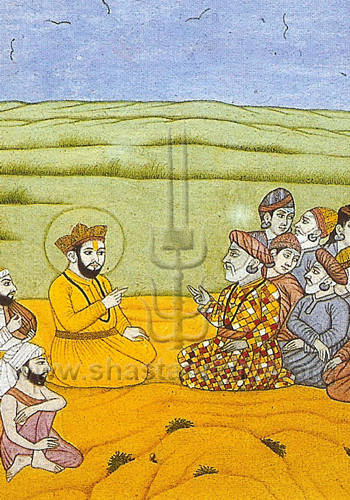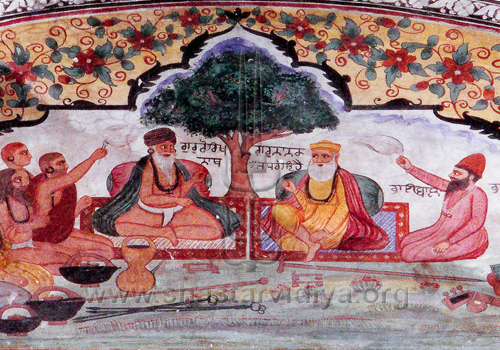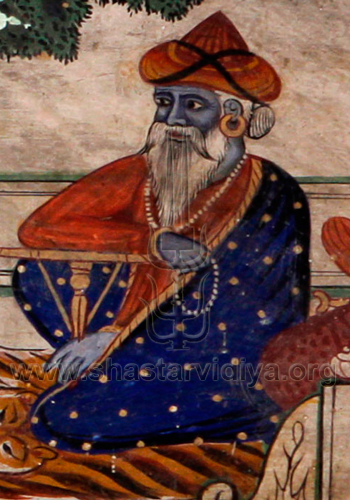"�these bands developed their own rituals and fighting methods, which may be traced to the Kaplikas, while having a common devotion to Siva�"
(Hindu Arms and Ritual)
After 5th century A.D., the Rajputs established their great kingdoms across India and a new Golden Age began for Sanatan Hindu Dharma. Hindu faith, art, and sciences flourished as never before in this era of stability. It was around this time that the dark Kapalika Sadhus transmuted into the more socially acceptable 'Natha Sadhus' (the masters of Yoga).
The militant ascetics amongst these 'Natha' (the masters) kept the legacy of the 'Shiv Akhara' (martial school of Shiva) alive. The greatest of the Natha masters was a Punjabi named Gorakhnath (also known as Gorakshanath).� His followers came to be known as 'Gorakhnathi' - the guardian masters of the world. Gurdev Gorakhnath's teacher was the 9th century Shivite Sadhu named Munivar Machindernath (also known as Matsyendranath), to whom it is said that 'Adi Natha' (primordial master) Shiva had himself imparted the wisdom of 'Hatha Yoga' (forced yoga). Machindernath himself is one of the 84 'Mahasiddha' (supreme masters of yoga).
The exponents of Gorakhnath's teachings spread all over India. It is highly likely that it is through the actions of these well-travelled Yoga masters and warrior ascetics that Indian martial arts spread through India and beyond. At the time, the Vasyan and Majapati Hindu empires extended into Indo-China providing impetus to South East Asian martial arts such as Pentac Silat and the Filipino arts. As time passed, these sophisticated militant Shivite Sadhus held great sway over many prominent Indian Rajput kingdoms:
"Natha Yogis were thought to be the power behind the throne of several Rajput kingdoms, especially Jodhpur, and Merwar."
(Susan Snow Wadley, Raja Nal and the Goddess: The North Indian Epic Dhola, (Indian University Press, 2004), 61)
Other than the Gorakhnathis, a number of other Shivite Akharas, conversant with Shastar Vidiya, also emerged to guard the Sanatan Dharma of India, including:
"...the 'Anand Akhara' (Founded 856), 'Niranjani Akhara' (Founded 904), 'Juna Akhara' (Founded 1106), 'Agani Akhara' (Founded 1482), 'Avahan Akhara' (Founded 1547), 'Atal Akhara' (Founded 1646), and 'Nirvani Akhara' (Founded 1749)."
(Robert Elgood, Hindu Arms and Ritual, Arms and Armour from India 1400-1865, (Eburon Academic Publishers, 2004), 44).
"�these bands developed their own rituals and fighting methods, which may be traced to the Kaplikas, while having a common devotion to Siva�"
(Ibid)
In the 10th century, Islam arrived in the north of India, and it was the Gorakhnathis who first engaged with these missionaries, mostly intellectually - and where need be, with the sword. In years to come the Gorakhnathis were seen as:
"�the first important religious groups to take to arms following the Muslim conquest."
(David N. Lorezen, Who Invented Hinduism: Essays on Religion in History, (Yoda Press, 2006), 51)
It is worth noting that the present day descendants of Guru Gorakhnath's disciples are considered to be the 'Ghurkha' people of Nepal - the only people of North India who remain unconquered. Guru Gorakhnath is recognised amongst the people of India to be the most intelligent person of his age; the master of paradoxical thinking. Even today, if one wishes to describe a complex task, thought, or concept, it is referred to as 'Gorakh dhanda' (work of Gorakh). Guru Gorakhnath is highly revered in all India as the 'Satgur' (true guru) of his age. Therefore, it is not surprising that another great son of the Punjab, Guru Nanak, paraphrased him extensively in the Adi Guru Granth Sahib (Sikh scripture):
"He is an ascetic who burns himself (i.e., effaces his ego). The alms he begs for is wrath of the world (i.e., seeks to make the world peaceful). In his heart he begs his alms. Such an ascetic attains onto the heaven of Shiva (i.e., finds eternal bliss in the infinite Brahm � the creator). Thus speaks Gorakhnath the form of eternal truth. In the highest essence (i.e., Brahm) there is no form or shape."
(Adi Guru Granth Sahib, Raamkali Ki Var, M:1, 952)
It is through these Gorakhnathis Sadhus that Shastar Vidiya was transmitted to the Sikhs.




